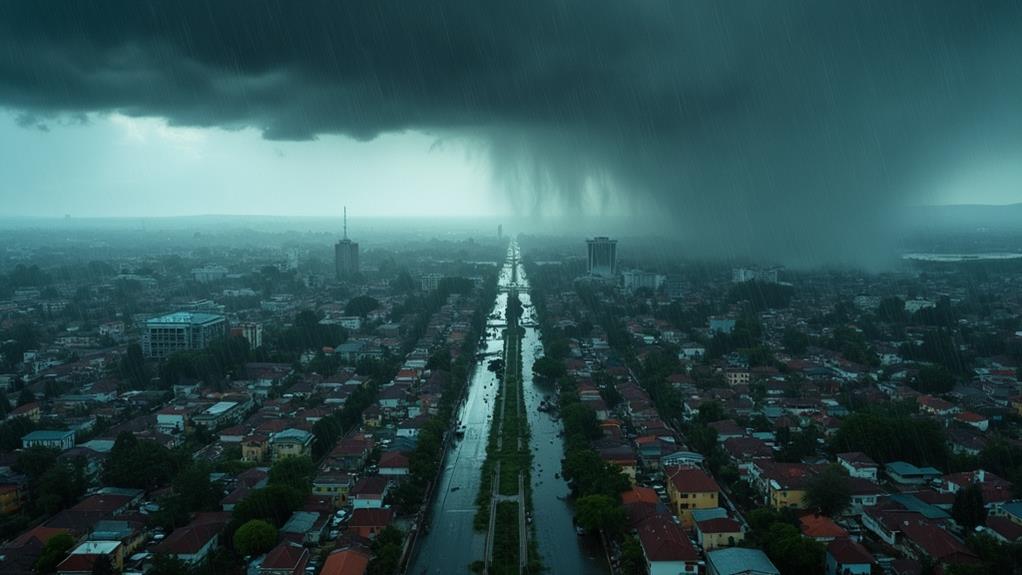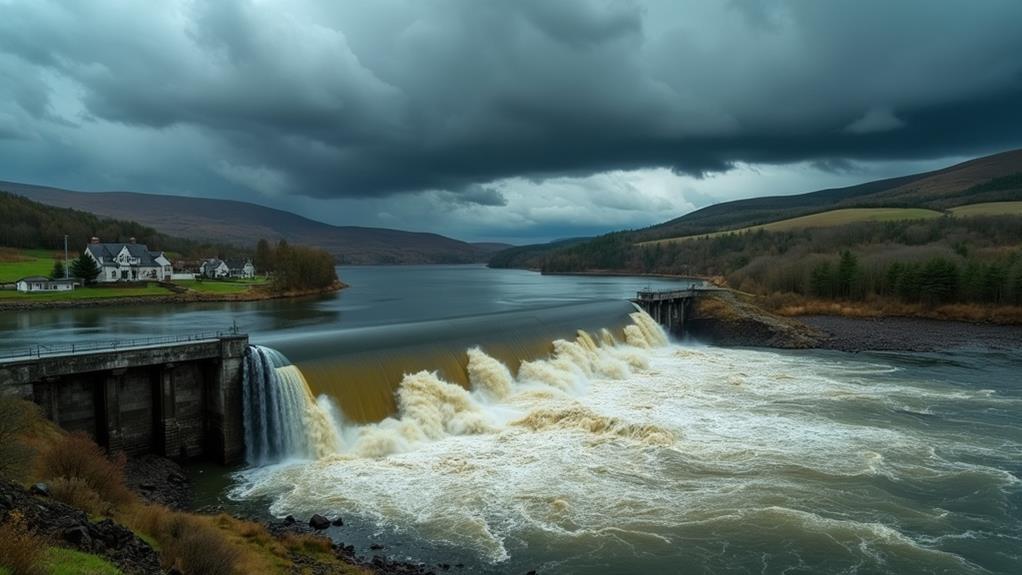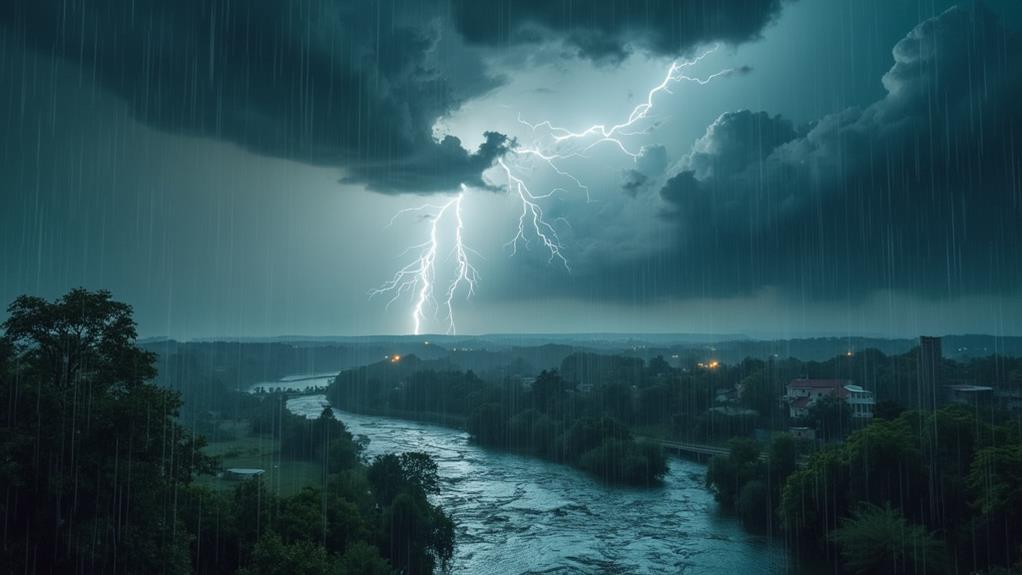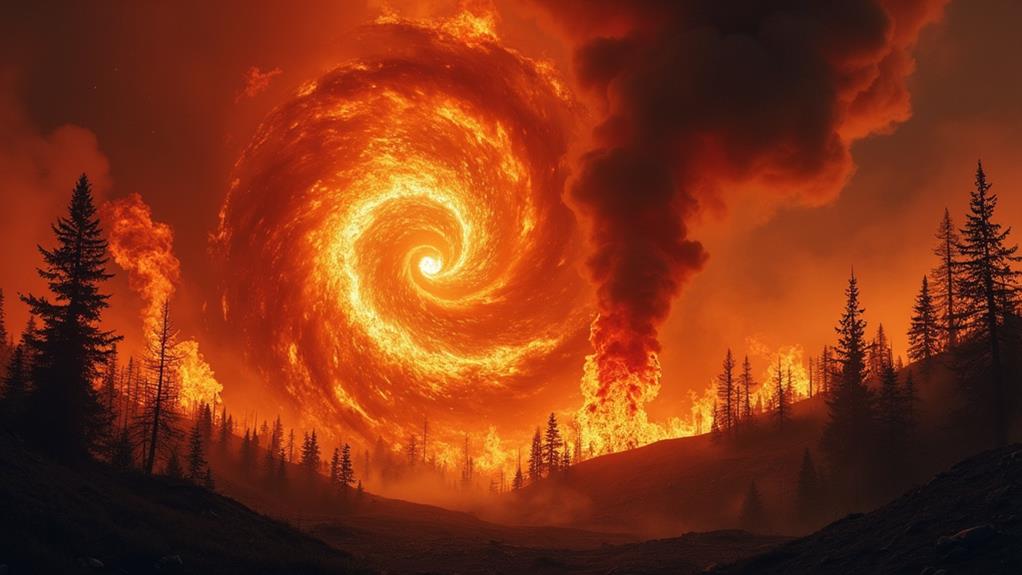Top Causes of Unexpected Flash Flooding Events

Unexpected flash flooding events are triggered by several key factors. Intense rainfall, especially when it exceeds 2 inches per hour, quickly overwhelms drainage systems. Urbanization and impervious surfaces like concrete increase runoff, leading to rapid flooding. Dam failures can cause catastrophic downstream floods, and debris or ice jams obstruct river flows. Climate change also plays a role, with rising temperatures causing more severe rainfall events. Moreover, weather patterns like El Niño, along with deforestation and poor land use, exacerbate flooding risks. By understanding these causes, you'll gain insights into how these fast-developing floods occur.
Key Takeaways
- Intense rainfall delivering over 2 inches per hour can trigger rapid flash flooding.
- Urbanization increases runoff due to impermeable surfaces, overwhelming drainage systems.
- Climate change intensifies rainfall and alters precipitation patterns, leading to unexpected flooding.
- Dam failures cause catastrophic flash floods downstream, often due to prolonged rainfall or negligence.
- Debris and ice jams obstruct river flow, causing sudden water accumulation and flooding.
Intense Rainfall
Intense rainfall is a primary trigger for flash flooding, often delivering over 2 inches of rain per hour in affected areas. This kind of downpour can lead to rapid runoff and significant water accumulation, especially in regions with poor drainage. Flash floods can develop within 6 hours of heavy rains, making them dangerous due to their swift onset and minimal flood warnings. In urban areas, the situation worsens as impervious surfaces like concrete and asphalt increase runoff, reducing the ground's ability to absorb water effectively.
During intense rainfall, water quickly accumulates, overwhelming drainage systems and causing flooding in streets and neighborhoods. Urban areas are particularly vulnerable, and the rapid rise of floodwaters can turn roads into rivers, posing significant risks to vehicles. Approximately half of flash flood fatalities occur in vehicles, underscoring the peril of driving during such events. Slow-moving storms or hurricanes often bring the kind of intense rainfall that can turn a regular day into a hazardous situation.
Urbanization
Urbanization significantly contributes to the frequency and severity of flash flooding events. As cities expand, the increase in impervious surfaces like concrete and asphalt prevents water absorption into the ground. When heavy rainfall hits, this leads to higher runoff, quickly overwhelming storm drainage systems. In urban areas, the infrastructure often can't cope with the rapid water accumulation, leading to flash floods.
In densely populated regions, the topography and infrastructure can exacerbate the effects of heavy rainfall. Urban development disrupts natural drainage patterns, causing swift-moving floodwaters to inundate low-lying areas and underpasses within minutes. This creates significant risks to both property and safety, particularly since almost half of flash flood fatalities involve automobiles.
The rapid runoff from impervious surfaces means water accumulates quickly, often catching people off guard. In many cases, storm drainage systems are simply not designed to handle such volumes of water in such short periods. This is especially dangerous in low-lying areas where water can pool rapidly, threatening homes, businesses, and lives. To protect yourself in these situations, always stay informed about weather conditions and avoid traveling through flooded areas, prioritizing your safety above all.
Dam Failures

While urbanization plays a significant role in flash flooding, another fundamental factor is dam failures. When a dam fails, it can lead to rapid and catastrophic flash floods downstream, as tragically demonstrated by the 1889 Johnstown Flood, which killed 2,200 people. With over 80,000 dams in the U.S., and one-third posing considerable hazards, the risk of structural failures, overtopping, or excessive seepage is high.
Prolonged rainfall, landslides, and human negligence are common culprits behind dam failures. During periods of heavy rainfall or snowmelt, a dam's capacity to manage water flow can be overwhelmed, greatly increasing the risk of failure. When this happens, the sudden surge of water can inundate nearby communities, causing extensive damage and loss of life.
Proper maintenance and regular inspections are imperative to preventing such breaches. Neglecting these important tasks can lead to weak spots in the dam structure, making them more vulnerable during extreme weather events. Ensuring that dams are well-maintained and structurally sound is critical for safeguarding communities from the devastating impacts of flash floods resulting from dam failures. It's a matter of vigilance and proactive management to mitigate these risks effectively.
Debris and Ice Jams
Debris and ice jams are formidable obstacles that can cause unexpected and severe flash flooding. When debris jams occur, natural and man-made materials like branches and logs obstruct river flow. This obstruction leads to water accumulation upstream, and when the jam breaks, it releases the trapped water abruptly, resulting in sudden flooding.
Ice jams are particularly problematic during winter and spring. These occur when ice builds up at bends or other obstructions in rivers. Historical data highlights the impact of ice jams, especially in colder regions like Alaska, where record floods have often been caused by these icy blockages. When an ice jam breaks, the sudden release of water can lead to flash flooding with little warning.
The consequences of both debris and ice jams are significant:
- Navigation Disruption: Obstructions in the river flow can disrupt waterway navigation.
- Hydropower Impact: Debris and ice jams can affect hydropower generation, leading to potential energy shortages.
- Costly Damages: Flooding from broken jams can cause extensive damage to infrastructure and property.
- Risk to Life and Property: Sudden flooding poses serious risks, making these jams a crucial concern.
Understanding and mitigating these jams is vital to prevent costly damages and safeguard communities.
Storm Systems

Recognizing the impact of debris and ice jams, it's just as important to understand how storm systems contribute to flash flooding. Storm systems, especially slow-moving thunderstorms and hurricanes, can release heavy rainfall, dumping over 6 inches in mere hours. Such intense rainfall can lead to a rapid onset of flash flooding, particularly in urban areas where impermeable surfaces increase runoff.
In urban settings, heavy rainfall from storm systems results in water levels rising swiftly due to the inability of the ground to absorb the excess water. This quick accumulation of runoff can turn streets into rivers within minutes. Thunderstorms can also cause localized downpours, triggering sudden flash floods downstream, even if the storm isn't directly overhead.
Storm systems that stall over an area are particularly dangerous. Prolonged rainfall dramatically heightens the likelihood of flash flooding, especially in low-lying regions that are more susceptible to water accumulation. Remember, flash floods can develop within just six hours of heavy rain, catching many off guard. While climate change and its effects on storm intensity will be discussed later, understanding the immediate impacts of storm systems is vital in predicting and preparing for these sudden flood events.
Climate Change
Shaping the landscape of modern weather patterns, climate change is driving the frequency and intensity of extreme weather events. You've probably noticed how sudden and intense rainfall seems more common now. This isn't just a coincidence. Rising global temperatures contribute to increased evaporation rates, putting more moisture into the atmosphere. When storms hit, they can release heavy rainfall, overwhelming local drainage systems and causing flash floods.
Climate change also alters precipitation patterns, making unexpected flooding more likely in areas that historically had infrequent heavy rainfall. Imagine living in a region where flash floods were rare, only to find them happening more often because the weather patterns have shifted.
Here are four key ways climate change contributes to flash floods:
- Increased Evaporation: Warmer global temperatures lead to more moisture in the air, resulting in heavier rainfall.
- Altered Precipitation Patterns: Changes in weather patterns cause some regions to experience unexpected, intense rain.
- Rapid Snowmelt: Higher temperatures speed up snowmelt in mountainous areas, adding to the potential for flash floods.
- Overwhelmed Local Drainage Systems: Sudden, intense rainfall can overwhelm these systems, leading to flooding.
Understanding these factors helps you grasp why flash floods are becoming more frequent and severe.
Frequently Asked Questions
What Are the Leading Causes of Flooding?
You might wonder what causes flooding. High rainfall intensity overwhelms drains, leading to urban runoff. Poor drainage systems can't handle sudden water volumes. River overflow happens when rivers exceed their capacity. Snowmelt events and coastal storm surges contribute considerably. Deforestation impacts and land use changes reduce water absorption. Soil saturation from previous rains and climate variability also play vital roles in flooding. Understanding these factors helps you stay prepared.
What Human Activity Causes Flash Floods?
Think of flash floods as nature's way of reminding us we're overstepping our bounds. When you engage in urban development, you replace absorbent ground with impervious surfaces. Deforestation effects and poor land use hamper water absorption, while inadequate drainage systems fail. Climate change intensifies storms, and river modification disrupts flow. Agricultural practices and construction runoff further exacerbate the issue. Effective water management is vital to prevent these sudden deluges.
Why Are Flash Floods Increasing?
Flash floods are increasing because of climate change and more extreme weather patterns, leading to heavier rainfall. Urban development creates impervious surfaces, causing higher runoff. Changes in land use, like deforestation, impact natural drainage and soil saturation. Rapid population growth stresses infrastructure resilience. Poor river management contributes to sudden floods. As a result, intense rainfall events, exacerbated by climate change, drive the rise in unexpected flash flooding.
Which of the Following Are Causes of Extreme Flood Events?
You need to know the causes of extreme flood events. Heavy rainfall, rapid snowmelt, and urban runoff often lead to flash floods. Deforestation impacts water absorption, while river dam failures release massive water volumes. Storm surges from hurricanes and poor drainage in urban areas exacerbate the problem. Soil saturation from prolonged rain and climate change intensify flooding risks. Land use changes also play a significant role in increasing flood events.




